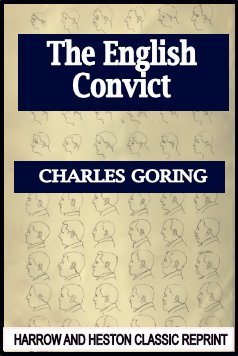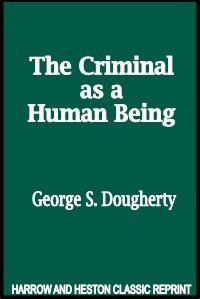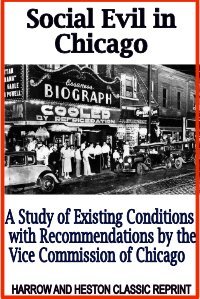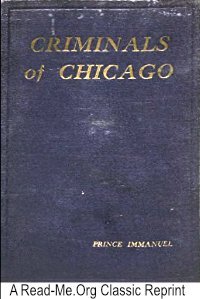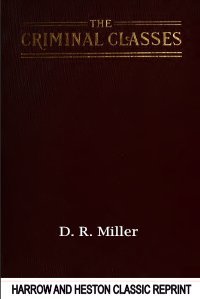By Charles Goring.
Classic statistical study published in 1913 measuring nearly 100 physical and mental characteristics of English convicts to determine their deviation from the normal. Notable features of the author's research methodology were the use of the newly-developed Pearson product moment correlation coefficient and the method of comparing groups of both criminals and non-criminals for the same characteristics. The author's analysis of the data rejects the view that there are specific physical and mental characteristics identifying the criminal. He further concludes that the influence of heredity and the presence of mental defectiveness are far more significant factors than parental influence in the development of criminal behavior.
HMSO (1913) 450 pages.
By pages
The Mystery of the Unborn, by pages. “Dr. Wilson believed that criminals are born unfinished. The die is cast at birth. The lack of finish at birth explains the incompetent, the born tired, the unemployed. Then what is the use? Why not painless extinction of those who commit great crimes, and the sterilization of the feebleminded….” Albert Wilson.
John Bale et al., (1928) 477.
By Prince Emmanuel of Jerusalem.
“ History shows that hanging did not prevent petit larceny. So we have abandoned the policy of frightfulness in punishment and cannot revert to it even though it still has some few supporters. And yet we feel that the theory of punishment being deterrent is philosophically sound. …The first news from the Laboratory revealed the prevalence of feeble-mindedness among delinquents. “
Rosburgh Publishing (1921) 247 pages.
By D. R. Miller.
“A law demanding only a refrain from violence or abstinence from all that may injure others contains but the negative, while it is lacking in the more important, the positive elements. If men, by closing their eyes to the existence of evil, could thereby banish it, then might it be best for all to close their eyes….it is quite certain that we can never hope to discover, through ignorance, what are the various types of criminal abnormality, nor know the many causes or cures for such estrangements. An intelligent and thorough study of the criminal problem will eliminate from our creed that fatalistic formula which asserts that ‘Evil is good not understood’…”
United Brethren Publishing House (1903) 224 pages.
By Carl Murchison.
“This material is offered for the special consideration of lawyers, psychologists, siociologists, social workers, and all those who have to do with the formulation of criminal law, the treatment of criminals, and the molding of public opinion concerning the enemies of organized society…”
A Read-Me.Org Classic Reprint (1926) 483 pages.
By Filson Young.
With notes and introduction by Filson Young. “Most of the interest and part of the terror of great crime are due not to what is abnormal, but to what is normal in it; what we have in common with the criminal, rather than that subtle insanity which differentiates him from us, is what makes us view with so lively an interest a fellow-being who has wandered into these tragic and fatal fields.”
William Hodge (1910) 266 pages.
By Clarence Darrow.
“The physical origin of such abnormalities of the mind as are called ‘criminal’ is a comparatively new idea….It has not been long since insanity was treated as a moral defect….”My main effort is to show that the laws that control human behavior are as fixed and certain as those that control the physical world…”
Thomas Crowell Pubs. (1922) 225 pages.
By Ida Well-Barnett.
“Immediately after the awful barbarism which disgraced the State of Georgia in April of last year, during which time more than a dozen colored people were put to death with unspeakable barbarity, I published a full report showing that Sam Hose, who was burned to death during that time, never committed a criminal assault, and that he killed his employer in self- defense.”
Harrow and Heston Classic Reprint (1892) 63 pages.
By Horace M. Kallen.
A Manual for Judges, Practitioners, and Students, by Hans Gross. Translated from the 4th German edition . Introduction By Joseph Jastrow,. “ In short, the individualization of disease, in cause and in treatment, is the dominant truth of modern medical science. The same truth is now known about crime…” Published under the Auspices of The American institute of criminal law and criminologyBoston,
Little Brown and Co. (1911) 567 pages.
Translated by Gina Lombroso.
This is the classic work of the “father of criminology” Cesare Lombroso translated from the Italian by his daughter Gina Lombroso. Here was the idea of the “born criminal” and a detailed classification system according to body types and other physiological and physical features. The major work was “L’Uomo delinquente” that emphasized the atavistic origins of criminality.
NY. Harrow and Heston Classic Reprint. (1876) 251 pages.




